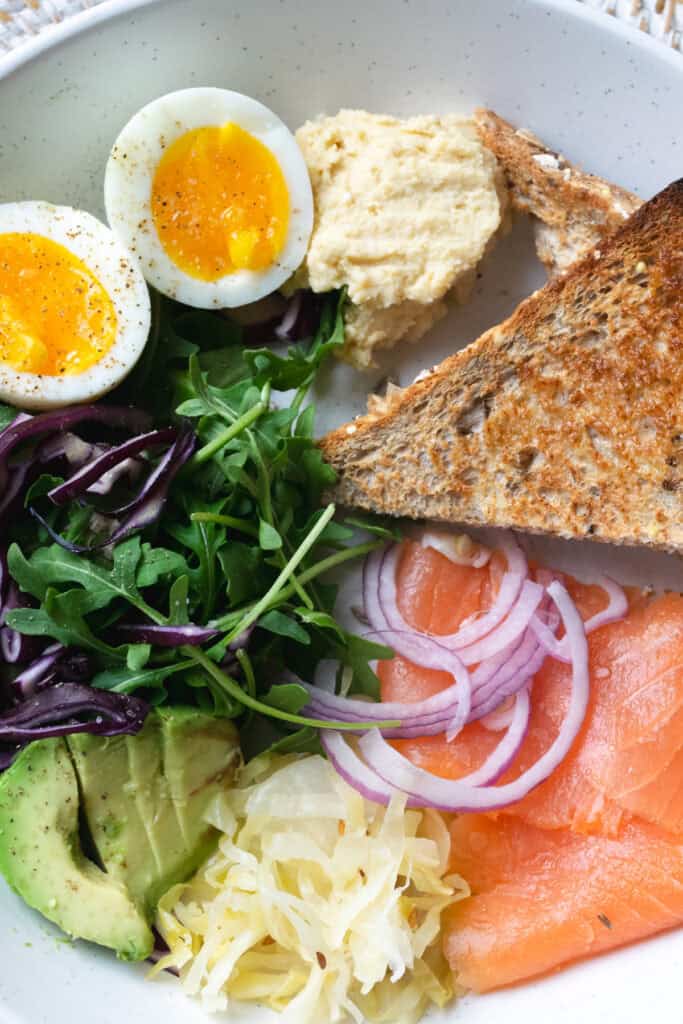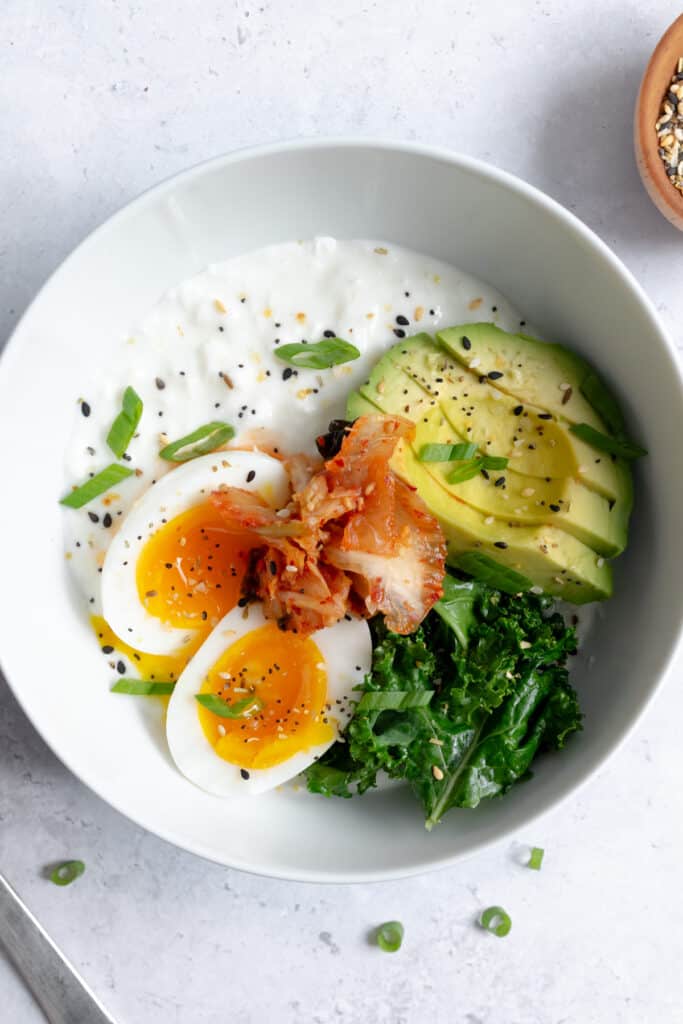
Before I went to school for holistic nutrition, I had already been on my health journey for a few years and was eating what I considered to be a pretty healthy diet. I ditched the package food, was eating plenty of whole foods, and exercising regularly. However, something was still missing. My energy levels were all over the place, I found myself hungry shortly after eating, and was craving sugar and carbs throughout the day. It wasn’t until I learned more about nutrition that I started to realize that even though I was eating healthy, I had been missing a piece of the puzzle. I wasn’t at all paying attention to how my meals were affecting my blood sugar.
Why is Blood Sugar Balance Important?
Blood sugar balance isn’t just something people with prediabetes or diabetes need to pay attention to. Balanced blood sugar levels can have a huge impact on our quality of life and is essential for reaching nearly any health goal.
When balanced, not too high or too low, our energy and mood are stable, we sleep well, have less food cravings, and our hormones are supported. However if imbalanced, it can lead to anxiety, low energy, trouble concentrating, poor sleep, irritability, increased cravings for sugar and carbs, brain fog and weight gain, especially around the waist. In the long term, it can put you at risk for developing heart disease, diabetes and other chronic health issues.
The good news is that small changes to our diet can make a big difference when it comes to blood sugar management.
What you eat for your first meal of the day is a great place to start. Starting the day with a balanced meal helps you avoid hopping on the blood sugar rollercoaster, which means you’ll have better energy throughout the day and be less likely to have to rely on caffeine and sugar.
Eating for Blood Sugar Balance
Every single time we eat, we have the opportunity to nourish our bodies in a way that supports our energy, mood, and overall health. Unfortunately, a lot of traditional breakfasts foods are loaded with sugar and have very little, if any, fibre or protein. That muffin or coffee you grab in the morning on the way to work might give you that quick boost of energy that you’re looking for, however it also causes blood sugar levels to quickly spike. Then they fall just as fast, leaving you exhausted, cranky, and craving another sweet treat that will spike your blood sugar levels again.
The first step in stabilizing blood sugar is to focus more on consuming high-quality whole foods and minimizing processed foods, which are often high in sugar, refined carbs and low in fibre and protein.
Next, you want to ensure you’re balancing your meals with a good source of protein, fibre and healthy fats. The three of these slow down the absorption of sugar into the blood stream, avoiding those large spikes. This means you feel more satisfied after eating, stay full for longer and have more stable energy throughout the day. Who doesn’t want that? This is especially important when you’re eating carbohydrates, which have the most impact on blood sugar. This could look like having your apple with some almond butter or a handful of nuts, adding some avocado and eggs to your sourdough toast or adding protein powder to your fruit smoothie.

Breakfast Ideas
Creating a breakfast that supports blood sugar doesn’t need to be complicated! Sometimes it’s just a matter of adding a good source of protein, fibre or fat. Here are some ideas for a healthy, blood-sugar balancing breakfast:
1. Eggs
I’m a huge fan of eggs for breakfast. Fried, scrambled, poached, hard boiled, baked – they’re all delicious and super nutritious! Eggs are full of protein, choline, vitamin D and B12. Pair them with some veggies (fibre) and avocado (fat) and you have yourself a delicious meal to start the day. Here are some of my favourite ways to enjoy them:
- Frittata with pesto and greens
- Sourdough toast topped with avocado, cottage cheese and poached eggs
- Hard boiled eggs with smoked salmon, spinach and sweet potato
- Breakfast tacos with soft scrambled eggs, chicken sausage or black beans, spinach, avocado and salsa
- Veggie, sausage and egg hash with avocado
2. Chia seed pudding
Chia seed pudding is the perfect make-ahead option for those busy mornings. Chia seeds are a good source of fibre and omega 3 fats. The flavour combinations are endless – chocolate, vanilla, pumpkin spice, strawberry. Adding some protein powder is a good way to boost the protein content as well. Not a fan of the texture of chia seed pudding? Try blending the mixture before allowing it to sit overnight. In the morning top it with your favourite nut butter, blueberries or some yogurt.
3. Yogurt breakfast bowls
Unsweetened, full-fat greek yogurt is packed with protein and makes a great base for a delicious yogurt bowl. You could also use an unsweetened plant-based yogurt if you’re dairy-free. Top with fresh or stewed fruit, nuts and seeds, low-sugar granola, or a crumbled home-made muffin. For an extra dose of protein, try adding some protein powder to the yogurt. One of my favourite yogurt breakfast bowls is greek yogurt mixed with pumpkin puree, vanilla protein powder and pumpkin pie spice, topped with sautéed apples, nut butter and a little granola. I’ll often have this with a side of eggs to make it a more filling meal.
4. Cottage cheese bowls
If you eat dairy, cottage cheese is a really easy way to get in a bunch of protein. A cup will give you around 30g of protein. You can either go the sweet route and top it with some berries or try savoury by topping with eggs, avocado and some cooked veggies (my personal favourite).
5. Protein smoothies
Smoothies are a super quick and nutritious breakfast option, however the ingredients you use will affect your blood sugar in different ways. Instead of relying solely on fruit, try adding a scoop of your favourite protein powder, a spoonful of nut/seed butter or avocado for some healthy fats and a handful of greens or frozen zucchini for some extra fibre and a serving of veggies. Adding some greek yogurt is also a great way to add some additional protein to your smoothie.
6. Leftovers
Breakfast doesn’t always have to look like what we typically think of as “breakfast foods”. Eating leftovers from dinner the night before is actually a great high-protein option. I’ll often take leftover veggies and protein, reheat it in a pan and then add a fried egg. It’s filling, tastes great and helps reduce any food waste!
Next time you reach for breakfast in the morning, focus on getting in enough protein and include some sort of healthy fat and fibre.. Being a little more aware of what we eat first thing in the morning and how it can affect our blood sugar can make all the difference in how we feel for the rest of the day and avoid those crashes later on!
